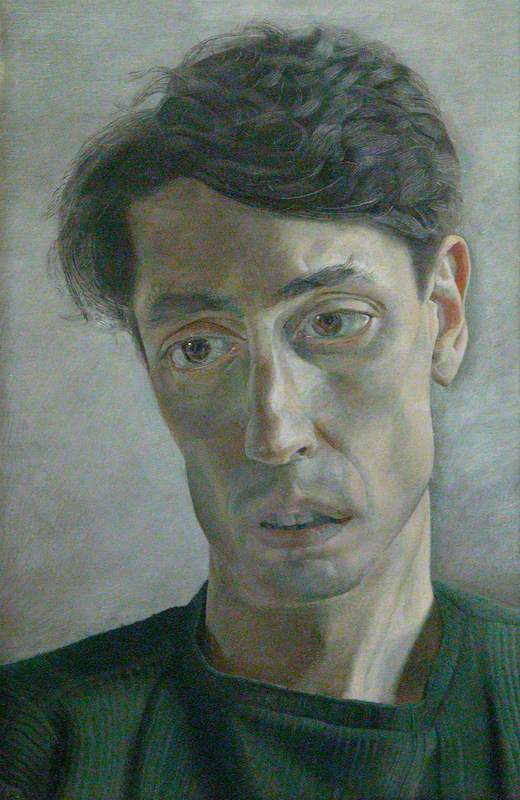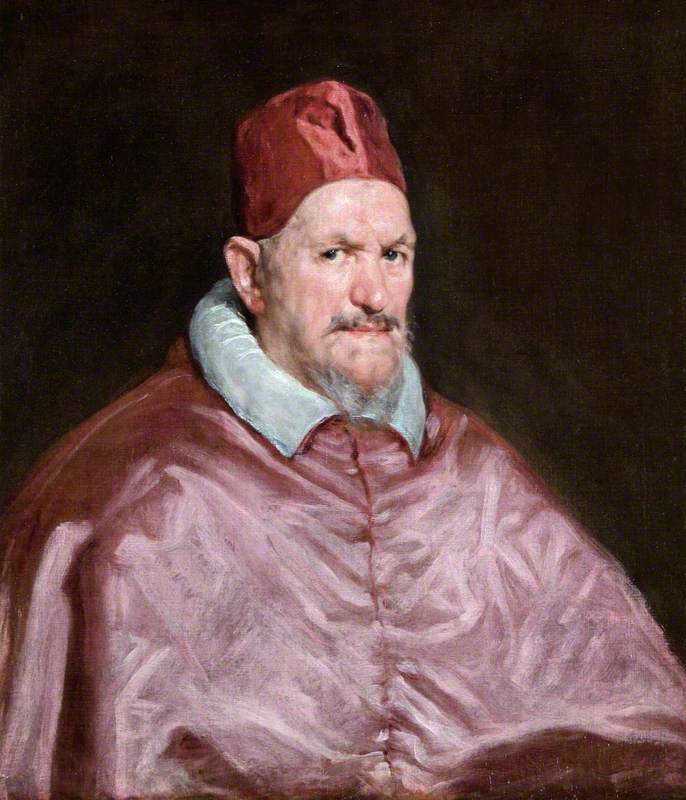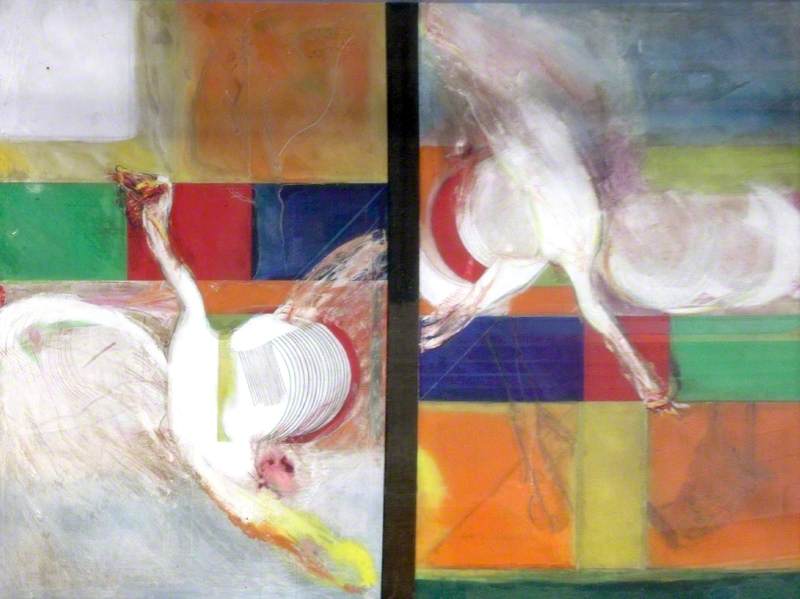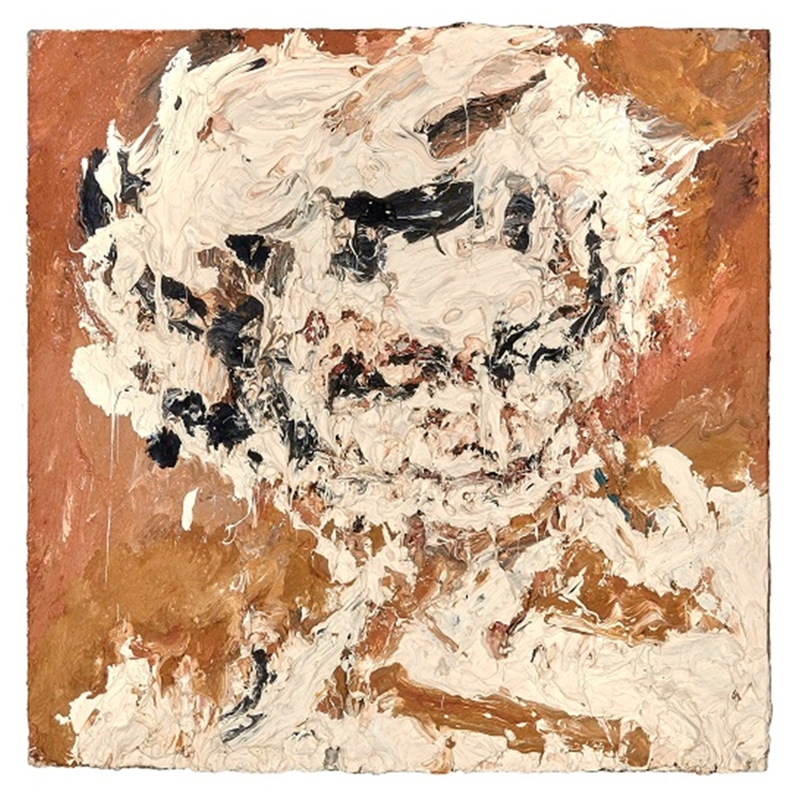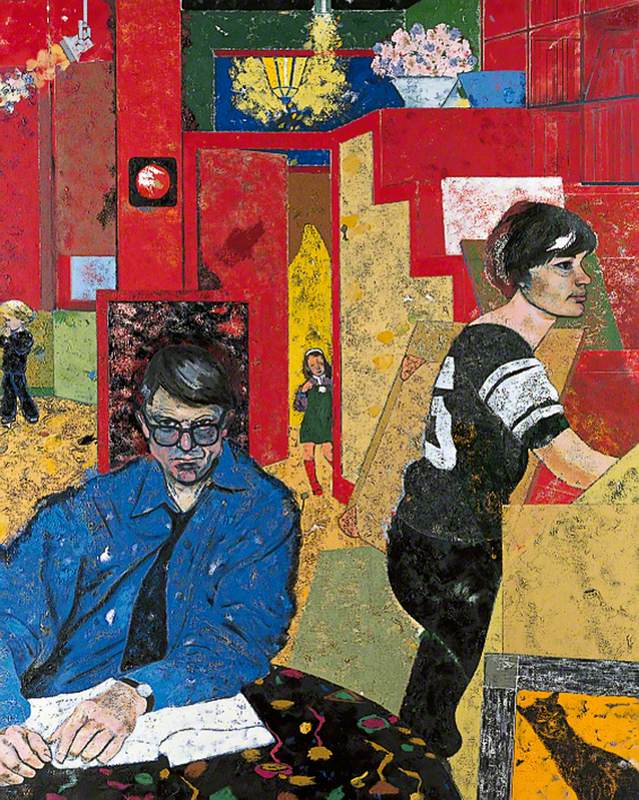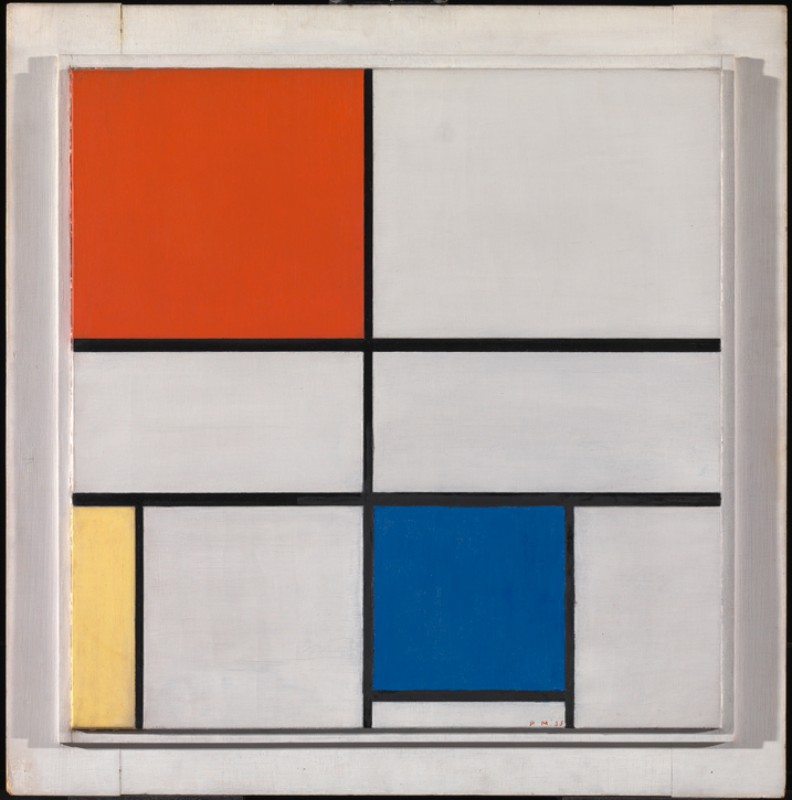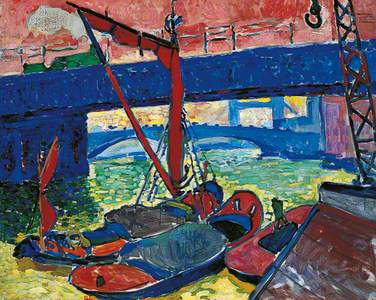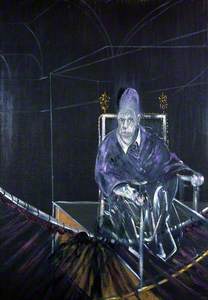This summer twelve UK museums come together with Art UK and Sotheby's to stage a month-long exhibition celebrating the UK's central role in the creative lives of leading international artists.
The free exhibition 'London: An Artistic Crossroads' is on diplay at Sotheby's New Bond Street Galleries from 25th May to 5th July 2024.
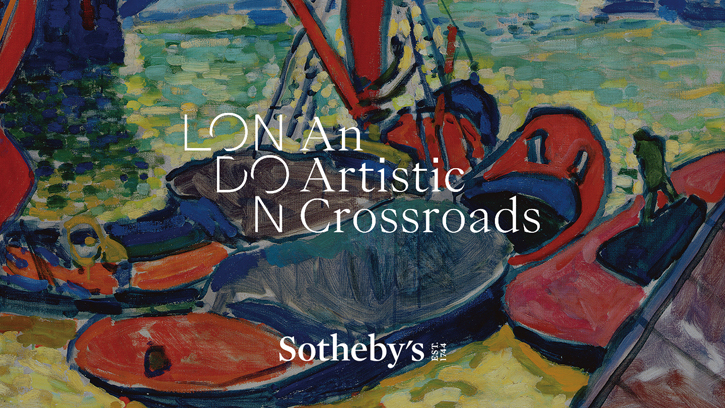
© ADAGP, Paris and DACS, London 2024. Image credit: Leeds Museums and Galleries
London: An Artistic Crossroads
Detail of 'Barges on the Thames', 1906, oil on canvas by André Derain (1880–1954), Leeds Museums and Galleries
For centuries, the UK's creative energy, cultural diversity, and rich heritage and culture of patronage have acted as compelling magnets for visitors and creatives alike. The nation has long been a cultural melting-pot for artists from around the world who, in their own unique ways, have revealed with each touch of brush, the impact of the dynamic environment in which they found themselves.
From Holbein, Rubens and Van Dyck (along with their contemporaries Orazio and Artemisia Gentileschi) to Angelica Kauffmann, Canaletto and Géricault; and from Whistler, Sickert and Sargent to Monet, Derain and Mondrian; from Lucie Rie, Paula Rego, Lucian Freud and Francis Bacon to Frank Auerbach, R. B. Kitaj, Frank Bowling and Magdalene Odundo – all these artists have found inspiration in the UK.
As a result, our vision of Britain today is largely informed by the imagery of artists from across the ages and across the globe, each of whom enjoyed a moment of creative flourishing here, informing the tradition of image-making we now define as 'British' and creating the images that inform our visual library.
In celebration of its role in the artistic journeys of so many, Sotheby's, in partnership with Art UK and twelve museums across the country, will stage a month-long exhibition, open to the public and free of charge, shining a spotlight on the UK as a centre of creative cross-pollination.
André Zlattinger, Deputy Chairman UK, Sotheby's, said: 'In its own unique way, the UK has for centuries been a magnet for artists, thinkers and writers from around the world, attracted both by a broad spectrum of patronage – from royal to mercantile – and a tradition of open-mindedness. The exhibition at Sotheby's will shine a light on this fascinating narrative, telling the tale of some of the artists who found inspiration, refuge, patronage and like-minded creative spirits in the UK. Their time here has often been marked by moments of exceptional artistic flourishing that underpin the rich, multicultural and innovative art scene that is as much a characteristic of the UK today as it always has been.'
Andrew Ellis, Chief Executive, Art UK, said: 'The UK holds arguably the greatest public collection of art in the world. Art UK brings together this collection, spread across nearly 3,500 institutions, and shares it online with a global audience of millions. To inaugurate our partnership with Sotheby's, this exhibition brings together a dozen stunning artworks primarily from museums outside London, highlighting the treasures to be found in our regional collections. It powerfully illustrates how the UK's rich cultural heritage draws on creators and influences emanating from well beyond our shores. All of us at Art UK greatly look forward to further collaborations with Sotheby's that showcase the UK's national art collection.'
Cécile Bernard, Managing Director, Europe, Sotheby's said: 'It is tremendously exciting to mark the beginning of summer at Sotheby's with this exhibition, hosted together with Art UK. We have long admired the work that Art UK do to shine a light on our national art collection worldwide, and we share in their goals to make art accessible to all – for learning, research and, above all else, enjoyment.'
The exhibition 'London: An Artistic Crossroads' will bring together an assemblage of remarkable works by artists who passed through or settled in the UK during their lifetime. The earliest of the works is a vivacious portrait by Flemish artist Marcus Gheeraerts the Younger, who became one of the most sought-after portraitists in England during the sixteenth century.
It is joined by a vibrant landscape by André Derain, for whom London was a place of explosive transformation, as well as an iconic Composition by Piet Mondrian who, out of fear of German invasion and encouraged by Ben Nicholson, left Paris for Hampstead in 1938.
Lucian Freud, Francis Bacon and Dame Lucie Rie are included in the lineup, all émigrés, Freud from metropolitan Germany, Bacon from rural Ireland and Rie from Vienna, in addition to Frank Bowling, R. B. Kitaj and Dame Magdalene Odundo, among others.
The exhibition coincides with NG200 – the Bicentenary celebrations of London's National Gallery – which it is intended to complement. As The National Gallery launches its National Treasures programme, where twelve of the nation's most iconic and well-loved paintings from the collection are lent to twelve venues across the UK, this exhibition does the reverse: bringing twelve works from major regional collections together in the capital city.
The National Gallery has long provided a source of inspiration for creatives, who look to its rich collection to further enhance their own practices. Many of the artists presented in Sotheby's exhibition publicly acknowledged the museum's influence over their own styles and practice, including Bacon, Freud (the subject of a landmark National Gallery exhibition – 'New Perspectives' – in 2022/2023), Kitaj (who selected paintings for 'The Artist's Eye' exhibition at The National Gallery in 1980), Bowling and Auerbach, who was even invited to show his interpretations of some of The National Gallery's paintings in 1995.
A look inside the exhibition
Frances Howard (1578–1639), Duchess of Richmond and Lennox by Marcus Gheeraerts the younger
Marcus Gheeraerts the Younger was among thousands of Flemish protestants who fled to England from the Netherlands in the late 1560s, driven from their homeland by the Duke of Alva's persecution against those daring to defect from the Catholic faith. Gheeraerts was just six or seven years old at the time, arriving in London with his father, while his mother stayed in his hometown. Upon arriving in the capital city, the pair settled in a house near Cannon Street, surrounding themselves with fellow European artists and refugees.
Despite being raised in England, Gheeraert the Younger's artistic style remained distinctly Dutch. Speaking to his influence, art historian Roy Strong proclaimed that Gheeraert initiated a 'revolution' in English portraiture, introducing increased naturalism and tonality, and enhancing the modelling of his sitters, just as we see in this charming and intimate portrait of Frances Howard, Duchess of Richmond and Lennox, now in the collection of Compton Verney.
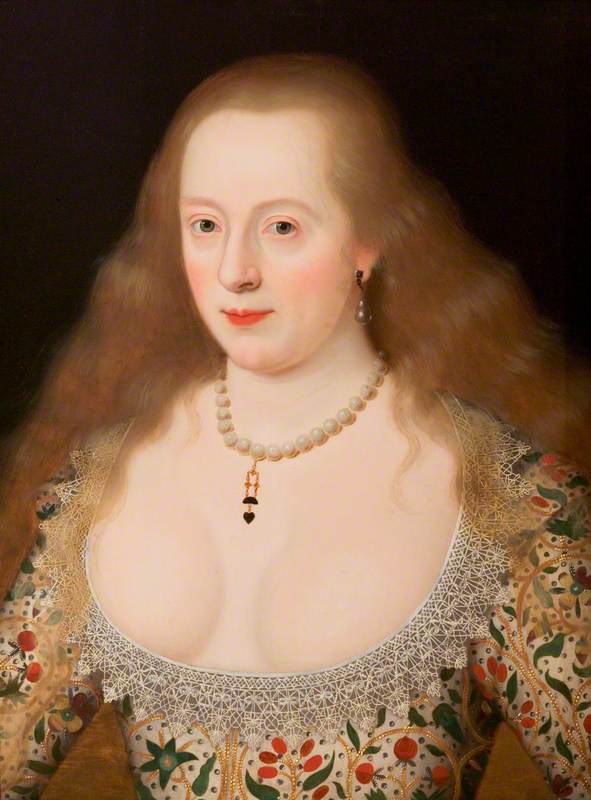
Image credit: Compton Verney
Frances Howard (1578–1639), Duchess of Richmond and Lennox c.1621
Marcus Gheeraerts the younger (1561/1562–1635/1636)
Compton VerneyCharles Townley and Friends in His Library at Park Street, Westminster by Johann Zoffany
'I am an Englishman, because in that country I found protection and encouragement.' Johann Zoffany
The painting Charles Towneley and Friends in His Library at Park Street, Westminister depicts a very early example of museum collectors in the UK. After the death of Charles Towneley, his collection was transferred to the British Museum providing a strong link between early museum collectors and East Lancashire where the painting now resides, in the collection of Towneley Hall.
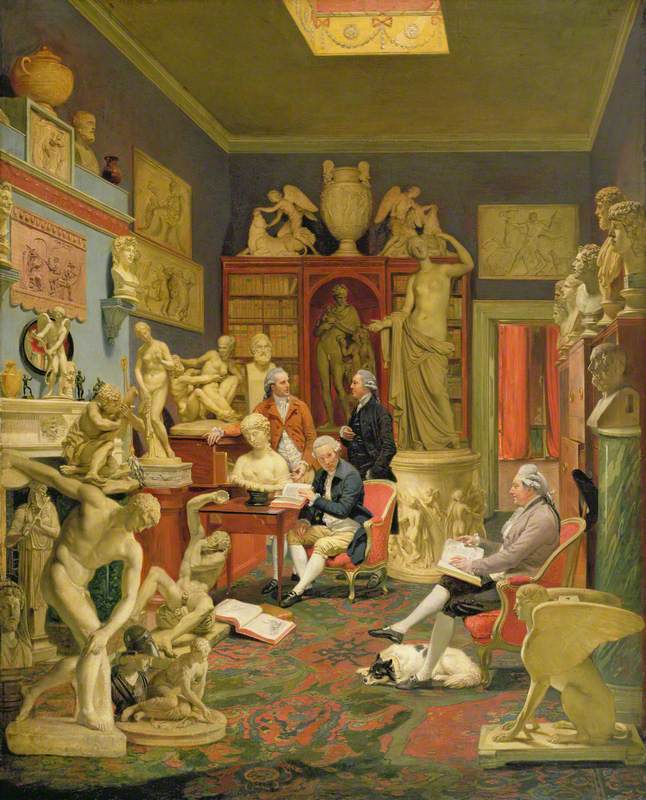
Image credit: Bridgeman Images
Charles Townley and Friends in His Library at Park Street, Westminster 1781–1790 & 1798
Johann Zoffany (1733–1810)
Towneley Hall Art Gallery & MuseumZoffany arrived in London in 1760, after completing his artistic training in Germany and Italy. London offered Zoffany access to wealthy patrons among British aristocracy and royalty, and he soon established himself as a portrait painter. His talent for capturing the likeness and character of his sitters led to commissions from prominent figures, among whom were Queen Charlotte and George III.
Painted in 1782, Charles Townley and Friends in the Library at Park Street, Westminster depicts Charles Townley, a renowned collector of ancient art, engaged in conversation with three fellow connoisseurs: Charles Astle, Charles Francis Greville, and Pierre-François Hugues d'Hancarville.
Barges on the Thames by André Derain
'This painting is no mere depiction of London, but a declaration of love: the painter's affirmation that the city had become his muse.' Andrew Graham-Dixon
Barges on the Thames, in the collection of Leeds Art Gallery, was painted during one of Derain's three visits to London over the span of ten months between the spring of 1906 and early 1907.
Derain was a mere 25 at the time, encouraged to make the journey from Paris to London by his dealer, Ambroise Vollard. The painting forms part of a seminal series comprising views of the city that rivalled Claude Monet's London paintings of 1899 to 1901. The previous year, Derain was named one of the most radical artists in Paris after his ground-breaking inclusion in the exhibition at the Salon d'Automne with Henri Matisse, where they were dubbed the Fauves, or 'Wild Beasts', in response to their use of vivid pure colour and free brushwork.
In complete contrast to Monet's smog-filled landscapes, Derain offered a different view of London with this series; the paintings are menacingly bright and fantastically colourful, capturing in the artist's own inimitable way the full vibrancy of the city. Derain painted some thirty canvases during his time in London.
Reclining Nude (Le lit de cuivre) by Walter Richard Sickert
Born in Munich to an artist father, Sickert moved to England at eight years old, and though he initially trained as an actor, his love of theatrical subjects soon channelled into painting – as he captured society in raw depictions of domestic, everyday settings.
This work from 1906, in the collection of Exeter's Royal Albert Memorial Museum & Art Gallery, depicts a naked figure on a bed with brass bedsteads. It takes on the age-old motif of the reclining nude and gives it a completely modern, rougher edge. At this time, the Royal Academy still insisted on the perfect realisation of the female body, just as the classical Greeks had.
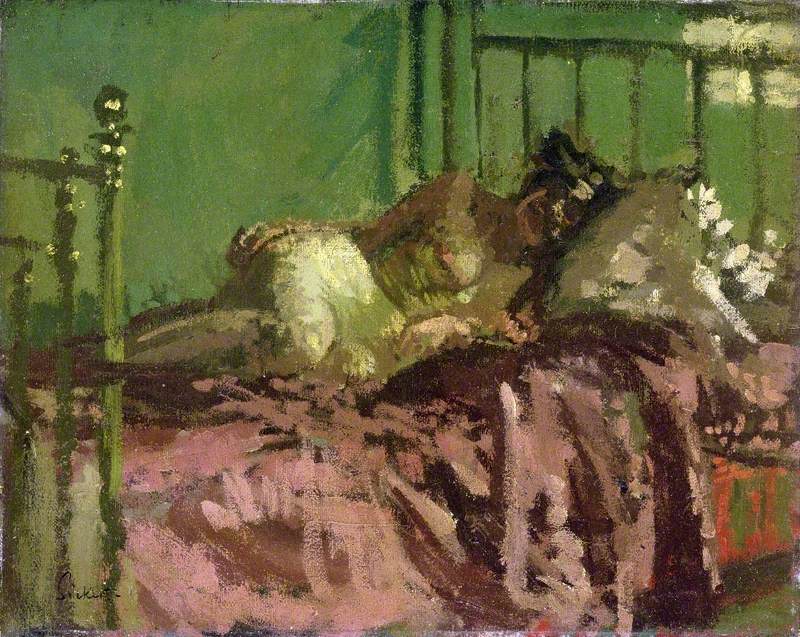
Image credit: Royal Albert Memorial Museum & Art Gallery
Reclining Nude (Le lit de cuivre) c.1906
Walter Richard Sickert (1860–1942)
Royal Albert Memorial Museum & Art GallerySickert rallied against this status quo, introducing a dark palette, dappled light and models with more of a chequered background. Sickert was at the forefront of key avant-garde groups in the early twentieth century, from the London Impressionists to the Camden Town Group. His legacy continued after his death, with many of the leading names in British contemporary art, from Francis Bacon and Lucian Freud to Lynette Yiadom-Boakye, influenced by his radical take on portraiture.
Composition C (No. III) with Red, Yellow and Blue by Piet Mondrian
Piet Mondrian's decision to move to London, prompted by the looming threat of a German invasion, marked a significant shift in his life and creative output. Encouraged to move here by fellow artists Naum Gabo and Ben and Winifred Nicholson, Mondrian took up residence in a flat in Hampstead, where he transformed the interior into a three-dimensional realisation of his iconic style – white walls adorned with patches of vibrant red.
During his time in London, Mondrian's productivity surged as he drew inspiration from the city's architecture and urban landscapes. The broad streets of Belsize Park and Hampstead, alongside historic landmarks like the Tower of London, left an indelible imprint on his evolving artistic vision.
Composition C (No. III) with Red, Yellow and Blue, painted by Piet Mondrian in 1935, is a pivotal work that foreshadowed the artist's subsequent move to London just three years later, and symbolises his evolving artistic journey during a transformative era.

Image credit: Tate Images
Composition C (No. III) with Red, Yellow and Blue
1935, oil on canvas by Piet Mondrian (1872–1944). Lent from a private collection, 1981, on long term loan to Tate
Notably, the painting featured in the 1936 pioneering exhibition 'Abstract & Concrete', the first international exhibition of abstract art in Britain, which brought together the works of 16 artists from nine different countries, including Alexander Calder, Naum Gabo and Piet Mondrian – all of whom were living in London at the time.
Composition C (No. III) was acquired by Helen Sutherland, who sponsored the exhibition, and subsequently became one of the first British collectors to own a work by Mondrian. Sutherland was also a key patron of Nicholson.
John Minton by Lucian Freud
'The reason I accepted [The Order of Merit] is because I'm a naturalised British subject and if my country of adoption gives me an honour I can't refuse it.' Lucian Freud
'When I first saw this painting, I was immediately struck by the elusive and restrained emotion in the subject's face. Freud's use of sedate colours and warm shadows creates an intimate portrait evoking a rich inner world of turmoil and play.' Professor Christoph Lindner, President and Vice-Chancellor, Royal College of Art
Lucian Freud arrived in London with his family in 1933, aged just ten years old, to escape the rise of Nazism. His earliest love was drawing, and he began to work full-time as an artist after being invalided out of the Merchant Navy in 1942. In 1951, his painting, Interior at Paddington, won a prize at the Festival of Britain, and after this, he built up a formidable reputation as one of the most powerful contemporary figurative painters.
Painted in London in 1952, Lucian Freud's portrait of his friend John Minton – a teacher and an artist himself – is a significant work produced during a crucial period in the artist's career.
For the most part, it was Freud who selected the sitter for his paintings, but in this case, it was Minton who commissioned the artist to paint his portrait, deeply impressed by a small-scale portrait of Francis Bacon, completed just a few months before.
Tragically, five years after this portrait was painted, Minton died of suicide after battling depression his entire life. Shortly before doing so, he bequeathed this portrait to the Royal College of Art, a gesture which not only indicated his approval of the picture but also displayed a considerable degree of bravery.
Pope I (Study after Pope Innocent X by Diego Velázquez) by Francis Bacon
'We are delighted to have been invited by Sotheby's and Art UK to be one of the twelve distinguished UK institutions lending masterpieces to the exhibition 'London: An Artistic Crossroads'. We're pleased that Sotheby's is showcasing the quality of Aberdeen's collection by including this important work in this loan exhibition, and that the portrait will be enjoyed by new audiences in London this summer.' Helen Fothergill, Aberdeen Art Gallery & Museums
Born in Dublin, Bacon left home in 1925 at the tender age of 16 and moved to London. Travelling to Berlin and Paris, he returned to the city in 1929, at a crucial time in his career. He had no formal training as an artist but used London as a source of inspiration and creativity. He avoided any public attention until 1945, when he exhibited Three Studies for Figures at the Base of Crucifixion and overnight became the most controversial artist in the country.
Bacon's Pope I (Study after Pope Innocent X by Diego Velázquez) from 1951 takes the Spanish master's portrait of Pope Innocent X from 1650 as its inspiration.

© The Estate of Francis Bacon. All rights reserved. DACS 2025. Image credit: Aberdeen Art Gallery & Museums
Pope I (Study after Pope Innocent X by Diego Velázquez) 1951
Francis Bacon (1909–1992)
Aberdeen Art Gallery & MuseumsAlthough Velázquez's portrait was hailed for its realism and accurate portrayal of an ageing man, Bacon's painting embodies the trauma and anguish of the post-war years.
Bacon's portrait was based entirely on reproductions: haunted and obsessed by the original work, the artist never saw Velázquez's painting (held in the Galleria Doria Pamphilj in Rome) in the flesh. However, it seems more than likely that the artist was familiar with another version of Velázquez's painting, one that has resided in Apsley House, the seat of the Duke of Wellington in London, since the beginning of the nineteenth century. Using the portrait as a template for his radical and unrelenting reinvention, Bacon worked on multiple versions for over 20 years.
Pope I (Study after Pope Innocent X by Diego Velázquez) was first exhibited in 1952 at The Hanover Gallery on Saint George Street in London, one of the most influential art establishments of its era, established by Erica Brausen, another German national. Coincidentally, that same year, the gallery also exhibited Freud's portrait of John Minton, though as part of a different exhibition.
Big Bird by Frank Bowling
Born in Guyana (then known as British Guiana) in 1934, Frank Bowling moved to London when he was just 19. It was a visit to The National Gallery in London that first sparked his interest in art: 'I was very struck by the British painters like John Constable, J. M. W. Turner and Thomas Gainsborough, whose marvellous touch I was engaged by.'
Studies at various London art schools soon followed, culminating in a scholarship to the Royal College of Art to study painting. Bowling was deeply inspired by Francis Bacon, and fellow students including R. B. Kitaj, Derek Boshier, Peter Blake and David Hockney. He graduated from the RCA in 1962 with a silver medal (Hockney won the gold) and would soon be recognised as an assured force in London's art scene.
Bowling painted Big Bird in 1964 and it's now in the collection of Liverpool's Victoria Gallery and Museum.
The influence of Bacon can be felt in its diptych structure, while the flat planes of colour laid out in a grid formation pay homage to Mondrian. The principal motif, of a swan with a bloodied beak, was based on an actual dying swan that he had seen one day while walking the shore of the Thames.
For Bowling, swans came to symbolise the different aspects of his life: despite achieving success in his career early on, his personal life was complicated, feeling 'the stresses of domestic life'. So, like a healthy swan, he appeared serene on the outside, but inside he struggled like a distressed or injured swan.
In 1966, Big Bird was submitted to the 'First World Festival of Negro Arts' in Senegal, where it won the grand prize for painting. Bowling was dispirited by the accolade, commenting that he would prefer to be known as a painter, not a Black painter. 54 years later, in 2019, having developed his work in multiple directions, Bowling was granted a retrospective at Tate Britain, with Big Bird fittingly taking pride of place in the very first gallery.
Head of Gerda Boehm by Frank Auerbach
Head of Gerda Boehm, in the collection of the Sainsbury Centre, Norwich, depicts one of Frank Auerbach's principal subjects – his older cousin, Gerda Boehm. Having escaped Nazi Germany under the Kindertransport scheme when just eight years old, Auerbach arrived in England in 1939. Gerda and her husband had emigrated the year prior and became the artist's only surviving relatives.
Between 1948 and 1955, Auerbach studied at St Martin's School of Art and the Royal College of Art, though it was the artist David Bomberg's evening classes at Borough Polytechnic which ultimately instilled his deep passion for painting. Auerbach would soon emerge amongst a new generation of painters – Francis Bacon, Lucian Freud and R. B. Kitaj among them – who built their reputations amidst the embers of war-torn London during the 1950s.
It wasn't until the following decade, in 1961, that Gerda Boehm first sat for Auerbach, although she would continue to do so every week until 1982. As in all of his portraits, Auerbach aimed to capture the raw essence, or rather the presence, of Boehm. Here, Auerbach builds layer upon layer of paint before the final form is fixed, quite literally as if the very essence of the subject becomes trapped in thickly worked impasto. In doing so, the boundaries of realism, expressionism, figuration and abstraction blur into one.
Bowl and Vase by Lucie Rie, 1972 & 1975 Crafts Study Centre, University for the Creative Arts
Lucie Rie was born and trained as a potter in Vienna, but fleeing the rise of Nazism, moved to London in 1938. In these early years, as she found her feet, she spent the wartime making a living by crafting ceramic buttons for the fashion trade. Her overriding ambition was to return to making pots, and soon she was back creating in full force from her studio at Albion Mews in the centre of London (going against the grain of retreating to more rural climes).
Nicknamed 'Lucie's hotel', her studio became a haven for the burgeoning post-war studio pottery movement, with the likes of Hans Coper flourishing there. Rie enjoyed great aesthetic acclaim in her lifetime, from a retrospective exhibition at the Arts Council in 1967 to her Damehood in 1991, and today ranks among Britain's greatest studio ceramicists.
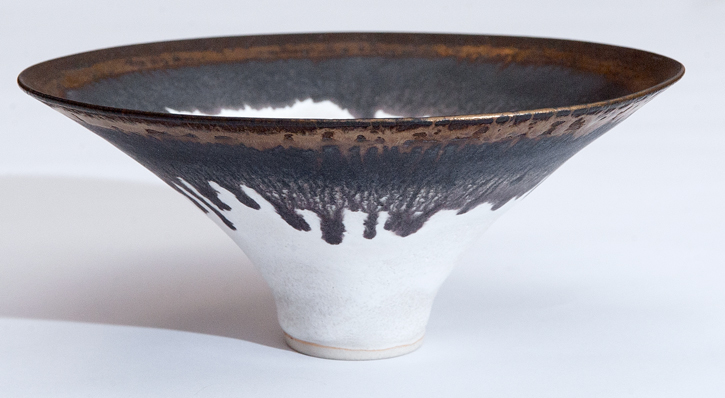
© the artist's estate. Image credit: University for the Creative Arts
Bowl
1975, ceramic by Lucie Rie (1902–1995)
Rie's work had an enormous impact on the landscape of British ceramics, inspiring a generation of potters that followed. The ingenuity of her practice lies in her masterful combination of modernist aesthetic and innovative decorative techniques. Her creative spirit is encapsulated by this 'spiral' vase and footed bowl, dating to 1972 and 1975 respectively, which showcase the characteristic richness of her glazing technique and the elegant shapes of her forms.
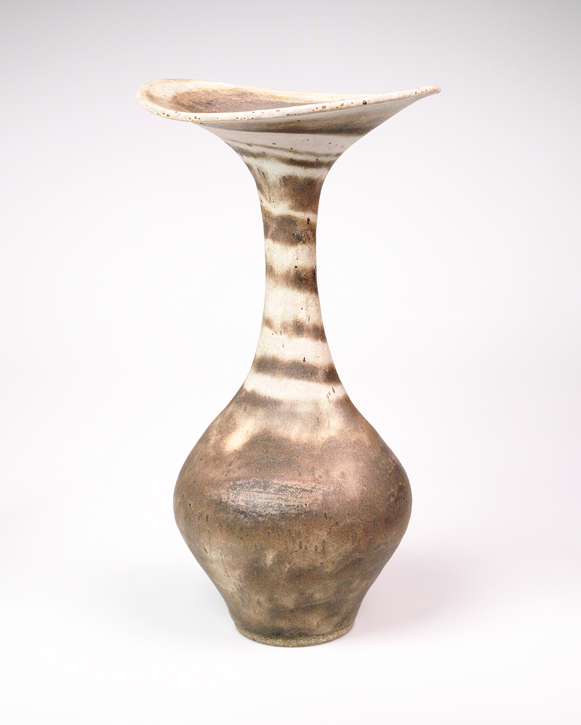
© the artist's estate. Image credit: University for the Creative Arts
Vase
1972, ceramic by Lucie Rie (1902–1995)
They are both in the collection of Crafts Study Centre, at the University for the Creative Arts.
The Architects by R. B. Kitaj
Kitaj lived in England for over 40 years, first moving to London in 1959 after serving time with the US Army. He studied at the Royal College of Art alongside David Hockney, with whom he remained lifelong friends. He engaged passionately with London and extended the tradition of Americans who for varying periods made it their home, and in 1982, became the first American Royal Academician since John Singer Sargent.
The Architects is a family portrait of M. J. Long and Colin St John Wilson, best known for their work as principal architects of the British Library. It was painted by Kitaj in 1979, during the period in which Long remodelled the artist's studio in Chelsea, forming the setting for the portrait. It is in the collection of Pallant House Gallery in Chichester.
Kitaj and Wilson were impressive bibliophiles and it quickly became apparent to Long that Kitaj's space would have to be altered to include as many books as possible. In 2010, Long described sitting for Kitaj's portrait, which she attributed to altering their friendly relationship.
Kitaj found the work frustrating, Long often felt intimidated by the sittings, and the artist would often become irritable. However, when this painting was finished, which Kitaj described as a transitional work, he could boast a new era to his oeuvre.
Tall Burnished Bottle by Magdalene Odundo
Magdalene Odundo was brought up in Nairobi and Mombasa, moving to the UK in 1971 to study graphic and commercial arts. It was here that she discovered a love of making pots, making studio visits to Bernard Leach and then Matthew Cardew before going on to hone her skills at the Pottery Training Centre in Abuja, Nigeria.
Having trained in the pottery traditions of both England and Kenya, Odundo also takes inspiration from a wide range of references – from ancient Egyptian and Greek vessels to modernist sculptures by Constantin Brâncuși – enriching British art with this wealth of cross-cultural inspiration.
This elegant long-necked, hand-built in 2009, was fired in an oxidising atmosphere to give a brilliant gleaming terracotta surface, and takes the form of an amphora, with a beautifully poised flaring neck. It is in the collection of Aberystwyth University Art Museum.
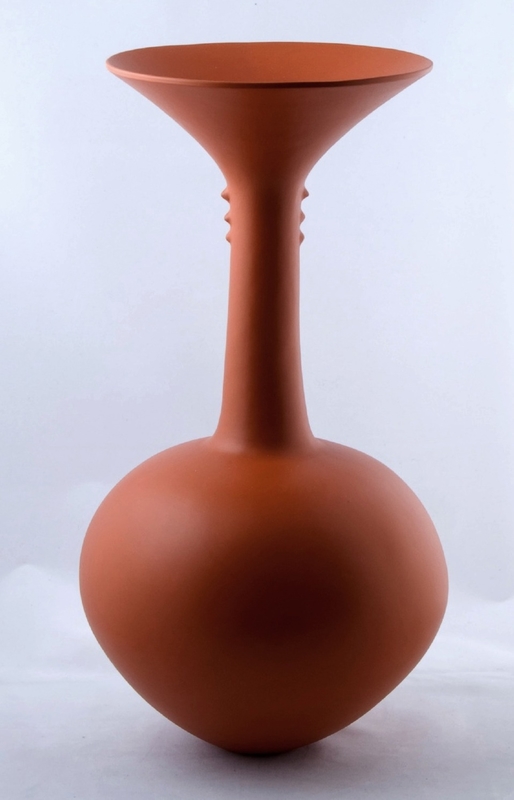
© the artist. Image credit: Aberystwyth University School of Art Museum and Galleries
Magdalene Odundo (b.1950)
Aberystwyth University School of Art Museum and Galleries'London: An Artistic Crossroads' will run from 25th May to 5th July 2024 at Sotheby's New Bond Street, and will be complemented by a rolling series of adjacent exhibitions and auctions, including material that further illuminates the central theme.
There will also be a series of free events, including a late-night opening and a series of panel discussions, drawing on the voices of some of the UK's leading creatives, many of whom will also contribute to an innovative audio guide, created by Bloomberg Connects.
You can download the free exhibition tour within Art UK's guide on Bloomberg Connects.

